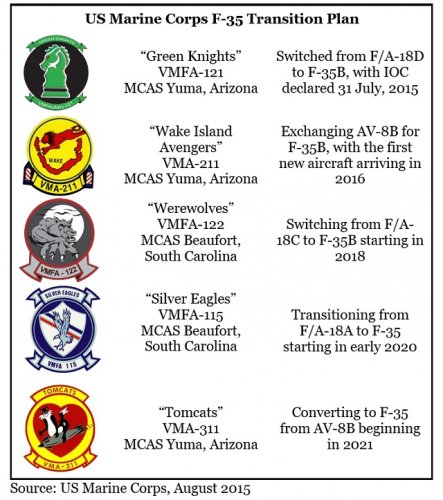The Marine Corps’ Lockheed Martin F-35B Lightning II Joint Strike Fighter (JSF) will have the stealth of a fifth-generation fighter and a weapons payload surpassing a fourth-generation fighter by the time a software upgrade is ready for fielding in 2017, the Marines’ top aviator said this week.
The aircraft’s ability to alternate between accessing contested areas and deliverying heavy fire power based on the needs of any given sortie “I think for our adversaries will be quite worrisome, for us should be a source of great comfort,” Deputy Commandant of the Marine Corps for Aviation Lt. Gen. Jon Davis said Wednesday at an event cohosted by the Center for Strategic and International Studies and the U.S. Naval Institute.
“No other airplane can go from fifth to fourth and back to fifth again. I’m buying pylons for the airplane. I get the pylons in 3F software, which comes in 2017. [With the pylons] I can load up an F-35B with about 3,000 pounds more ordnance than I can put on an F-18 right now,” Davis said.
“So I can have an airplane that does fifth-generation stuff for the opening salvo of the fight. When I have to go to level of effort, I can load the pylons on, load ordnance on there, do level of effort, come back, sail to another part of the world, take the pylons off and go do the fifth-generation thing again. … It offers us tremendous capability for the Marine Corps that’s going to have one type/model/series aircraft that can go fourth and fifth gen, give us that fighter capability, give us that attack capability that we need in the out years.”
F-35 Lightning II Program Office spokesman Joe DellaVedova told USNI News that the F-35 was designed to be relevant both on Day 1 of a fight and Day 365 of a fight. To that end, the services needed to leverage the stealth capability that the Air Force already had in its Lockheed Martin F-22 Raptor fighter and Northrop Grumman B-2 Spirit bomber, as well as the fire power Marines needed to support their Marine Air-Ground Task Force (MAGTF).
The low-observable design of the F-35B, when left unaltered, would allow the Marines to sneak into anti-access/area-denial airspace, take out the integrated air defense system and other high-value targets with its 4,000 pounds of ordnance in the internal weapons bay, and leave. Once the pylons are ready in 2017 to be affixed to the exterior of the plane, “after you dismantle the enemy’s air defense system…then that F-35 can be loaded up like a traditional legacy fighter and become an 18,000 bomb truck, when you don’t have to rely on the low-observability any more,” DellaVedova said. The pylons optimize the F-35B for close-air support, anti-air missions and more.
DellaVedova said testing for the pylons and development of the rest of the 3F software upgrade package is ongoing. The Marines’ current 2B software allows them to carry two air-to-ground weapons and one air-to-air weapon internally: the 1,000-pound GBU-32 Joint Direct Attack Munition (JDAM), the 500-pound GBU-12 Paveway II laser-guided bomb and the AIM-120C Advanced Medium-Range Air-to-Air Missile (AMRAAM).
An F-35B test aircraft flies in short takeoff/vertical landing more in external pylons and stores loaded March 20, 2013. Photo courtesy F-35 Lightning II Program Office.
An F-35B test aircraft flies in short takeoff/vertical landing mode with external pylons and stores loaded March 20, 2013. Photo courtesy F-35 Lightning II Program Office.
The 3F software upgrade will bring the external weapons pylons, 4.1 or 4.2 will bring the all-weather Small Diameter Bomb, and in the future the Marine Corps will look to adapt foreign weapons used by partners in the international JSF project, Davis told USNI News last month.
Davis made clear at Wednesday’s event that the F-35B with its current 2B software configuration can handle challenging threat environments today.
“Bottom line, [Marine Fighter Attack Squadron] VMFA 121 just did an Operational Readiness Inspection to get them ready to convince us that they were actually indeed ready to go be declared initial operational capable, and they did a fantastic job in the interdiction mission we had them do, and the defensive counter air, the offensive counter air, the close air support and the armed reconnaissance,” Davis said
“The armed reconnaissance one was the most interesting one. We gave them a really high-end threat environment to go against, and normally to go do close air support and armed reconnaissance you want to be able to get into a kind of low-threat environment to go out there and look for targets. … We gave them difficult targets to find, and we also gave them a difficult threat that in my world, as [former executive officer and commanding officer of Marine Aviation Weapons & Tactics Squadron One (MAWTS-1)], would be a prohibitive threat. They went out there, they found those targets, they dealt with that, and they came back.”
Now that VMFA 121 passed the ORI and Commandant Gen. Joseph Dunford declared initial operational capability for the platform, the Marines will begin the slow process of standing down squadrons of F/A-18 Hornets, EA-6B Prowlers and AV-8B Harriers, and standing up squadrons of JSFs. All active-duty squadrons will be stood up by 2031, with the Marines buying 353 F-35Bs and 67 F-35Cs.
The Marines “intend to extract maximum value and service life out of our Harriers, Hornets and Prowlers,” Davis said in a statement, but the four remaining Prowler squadrons will be short-lived, with the Marine Corps retiring one a year beginning next year. Though a final decision on Harriers and Hornets won’t be made until 2019, the service expects that the Harrier squadrons will transition by 2026 and the Hornets by 2030.

